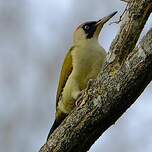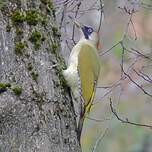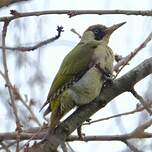European Green Woodpecker
Picus viridis - Pic vert
Identification
The European Green Woodpecker is a fairly large woodpecker, with a predominantly green plumage which has given it its name. This is the first thing you notice when confronted with this species. Then it is the vivid red of the head that stands out. The bright green, slightly tinged with yellow, covers the upper body, from the nape to the tail, as well as the coverts. The rump and tail coverts are clearly more yellow. The flight and tail feathers, of grey-brown, are clearly barred with blackish. The underparts are of a grayish white with a yellowish tint that increases in intensity from front to back. Thus, the throat and cheeks are whitish, while the lower abdomen is clearly yellow, but there are individual variations. The feathers of the back of the flanks and the undertail, yellowish and bordered with blackish, give an scaly appearance. The tricoloured head, red, black and white, is remarkable. Both sexes have a vivid red hood that reaches the nape, a black colour on the lores, the eye rim and the moustache, and finally the throat and parotids are whitish. The white iris stands out well on the black cheek. The beak is yellowish or horn, with a dark tip. The small sexual dimorphism of this species is located on the head. The male has a red band in the black moustache, while the female does not. The very clawed legs are brownish or grayish. The juvenile can be easily distinguished from the adult. It is much darker, less green, and its plumage is almost entirely marked with stripes, bars and mottles. The top is of dull green mottled with yellowish-gray. The underside is whitish-gray and is completely barred with blackish and the sides of the head have stripes of the same colour. The red of the cap is not as bright.
Subspecific information 3 subspecies
- Picus viridis viridis (n and c Europe)
- Picus viridis karelini (se Europe to sw Turkmenistan)
- Picus viridis innominatus (sw Iran)
Foreign names
- Pic vert,
- Pito real euroasiático,
- peto-real-europeu,
- Grünspecht,
- zöld küllő,
- Groene Specht,
- Picchio verde,
- gröngöling,
- Grønnspett,
- žlna zelená,
- žluna zelená,
- Grønspætte,
- vihertikka,
- picot verd comú,
- Grænspæta,
- dzięcioł zielony,
- zaļā dzilna,
- zelena žolna,
- Зелёный дятел,
- ヨーロッパアオゲラ,
- 绿啄木鸟,
- gröngöling,
- 黑枕綠啄木,
Voice song and call
The typical call of the European Green Woodpecker is a loud kiak, either isolated or repeated 3 or 4 times. The song is made up of the same note, repeated rapidly on average 10 times and forming a phrase that gradually decreases in volume. Young birds beg at the nest with a continuous che che che, typical of the family.
Habitat
The European Green Woodpecker is a forest species associated with deciduous wood, but can also be regularly found in mixed forests in the mountains and in the north of its range.
Behaviour character trait
We are drawn by a curious chuckle. A European Green Woodpecker flaps away in a wavy flight, punctuated by distinct kiaks. This is usually how we make our first contact with the species, which is not particularly shy, only discreet when on the ground foraging for food, because of the presence of predators. On the ground is, indeed, where this woodpecker searches for its insect-based diet. In urban areas, it is common to observe it hopping across lawns, completely exposed but still alert to its environment. It is not known to visit winter feeders, like the Eurasian Blue or the Grey, as it isn't interested in the food put out there, particularly seeds.
In the case of danger, it will seek refuge in the trees, concealing itself from the predator or trespasser by positioning itself behind a trunk or branch and turning around, whenever necessary, thanks to its powerful and sharp claws. Unlike the Greater Spotted, Eurasian Blue and others, this woodpecker only chips at wood for nest-building purposes. It is a solitary bird in-between mating seasons, living in territorially paired couples during the reproductive season, and in small family groups when the youngs become independent. The European Green Woodpecker is a sedentary one throughout its living range, migrating through only small altitude changes in mountainous areas. After Winter Solstice and with the increasing day-length, the European Green Woodpecker become vocal again and is able to express its territorial song. This song is exclusive to the male. It is with his voice that he shows his pre-eminence over his own territory, defending it against all rivals. In contrast, it doesn't hammer the wood, unlike another Picus, the Grey, which does to assert its territorial rights.Flight
The flight is typical of the bird family. The European Green Woodpecker alternates between fast and powerful beats and resting phases with its wings folded, which gives it a wavy, fast and direct flight. The flight is usually short and afterwards the woodpecker lands against a trunk or branch. Its short and rounded wings are related to the sedentary lifestyle and arboreal life of the species.
Dietfeeding habits
Although very arboreal, the European Green Woodpecker does not seek its food in wood. It feeds on the ground, hopping around looking for ant hills.
In fact, much of its diet consists of ants and their larvae which it removes from the ground with its long sticky tongue, garnished with small hooks at its tip and very tactile. It is an extraordinary weapon which can slip into the tunnels of the ground to harpoon the prey that is there. The woodpecker firstly digs the ground with its beak to access the ant tunnels, even in winter when the ground is frozen on the surface. It can also go through the snow layer to get to the ground. You often have the opportunity to see the result of its work on the Formica rufa ant hills (large domes of twigs) which it deeply pierces to get into the insects. The Black Woodpecker does the same. To a lesser extent, it can dig in rotten wood to find xylophagous larvae. It completes its diet with various invertebrates (earthworms, small mollusks, various insects), but also with fruits (apples, cherries, etc.), much more rarely with seeds.Reproduction nesting
Like all woodpeckers, the European Green Woodpecker is hole-nesting for breeding. It uses its powerful, sharp beak to excavate its nesting lodge in soft woods such as willows or poplars, but also fruit trees such as cherries, at a variable height from the trunk (from 2 to more than 10 meters).
This takes it several weeks of work. The entrance hole is circular, 6 to 7 centimeters in diameter. It may be slightly oval. An old lodge is often reoccupied. Vocal activity starts early, in fact as soon as the day period starts to increase again. From February, or later depending on latitude or altitude, the couples reunite and keep in contact with each other using their voices. Nesting starts in March-April with a nuptial parade where the male feeds the female until copulation, a way to solidify the bond between the partners. The female lays 5 to 7 eggs which she and the male take turns incubating for 15 to 17 days. It is the male that incubates during the night. The young ones hatch naked and blind. They are mainly fed ants and their nymphs by both parents. The young ones leave the cavity after 18 to 21 days, and still remain in the vicinity of the nest for a few days, seeking refuge inside it during the night. Then the family splits into two groups, each of the adults taking charge of a part of the young ones. The old nests, deserted by their owner, can be occupied by other hole-nesting species such as invertebrates (colony-forming wasps) as well as vertebrates (other birds like the Little Owl or mammals like various species of bats).Geographic range
The European Green Woodpecker has a quite restricted distribution. It is an essentially European species. Its range extends across the European continent from the Atlantic to the west of Russia to the Volga. All European countries house it, except for the island of Ireland and Spain where the close species, the Sharpe's Woodpecker, is living. In Scandinavia, it is only found in Southern Norway and Sweden. It overflows into Anatolia, reaches the Caucasus and skirts around the Caspian Sea to the south. An isolated population inhabits the Zagros mountains in Iran and northern Iraq. In France, it comes into contact in the eastern Pyrenees with the Sharpe's Woodpecker with which it hybridizes in a restricted area.
Threats - protection
Sources of information
- IOC World Bird List (v15.1), Gill, F and D Donsker (Eds). 2025-12-07.
Other sources of interest
 Specification sheet created on
06/07/2023 by Jean François
Specification sheet created on
06/07/2023 by Jean FrançoisTranslation by AI Oiseaux.net
© 1996-2025 Oiseaux.net
- Accipitriformes
- Aegotheliformes
- Anseriformes
- Apodiformes
- Apterygiformes
- Bucerotiformes
- Caprimulgiformes
- Cariamiformes
- Casuariiformes
- Charadriiformes
- Ciconiiformes
- Coliiformes
- Columbiformes
- Coraciiformes
- Cuculiformes
- Eurypygiformes
- Falconiformes
- Galliformes
- Gaviiformes
- Gruiformes
- Leptosomiformes
- Mesitornithiformes
- Musophagiformes
- Nyctibiiformes
- Opisthocomiformes
- Otidiformes
- Passeriformes
- Pelecaniformes
- Phaethontiformes
- Phoenicopteriformes
- Piciformes
- Podargiformes
- Podicipediformes
- Procellariiformes
- Psittaciformes
- Pterocliformes
- Rheiformes
- Sphenisciformes
- Steatornithiformes
- Strigiformes
- Struthioniformes
- Suliformes
- Tinamiformes
- Trogoniformes


































